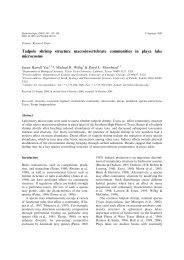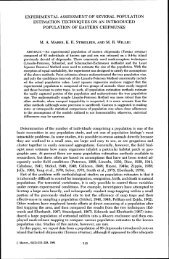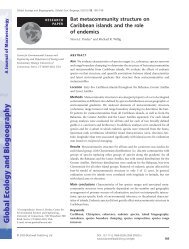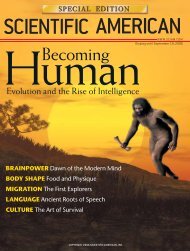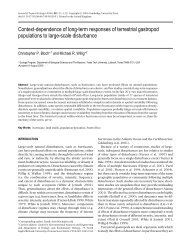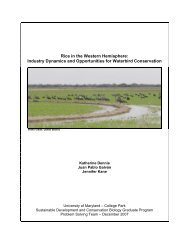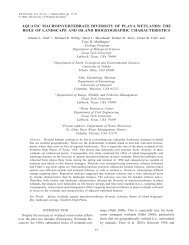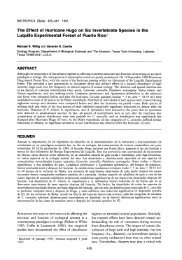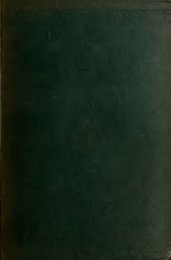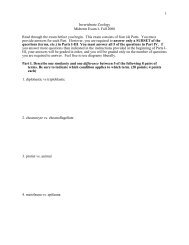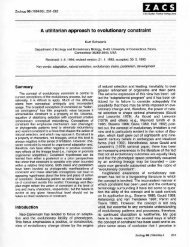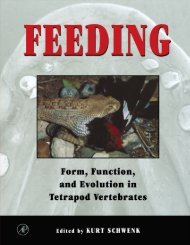Respiration and Circulation in Reptiles
Respiration and Circulation in Reptiles
Respiration and Circulation in Reptiles
You also want an ePaper? Increase the reach of your titles
YUMPU automatically turns print PDFs into web optimized ePapers that Google loves.
<strong>Respiration</strong> <strong>and</strong> <strong>Circulation</strong> <strong>in</strong><br />
<strong>Reptiles</strong><br />
Elizabeth Timpe<br />
Herpetology - EEB 3265/5265<br />
23 February 2010
Lecture Outl<strong>in</strong>e<br />
<strong>Respiration</strong> <strong>and</strong> <strong>Circulation</strong> <strong>in</strong><br />
<strong>Reptiles</strong><br />
• Oxygen transport<br />
– Div<strong>in</strong>g <strong>in</strong> aquatic <strong>and</strong> semi-aquatic species<br />
• Adaptations for O 2 uptake<br />
– Pulmonary<br />
– Extra-pulmonary (or nonpulmonary)<br />
• Hibernation <strong>and</strong> respiration<br />
• Changes <strong>in</strong> blood flow through the heart<br />
• Characteristics of blood*<br />
*will not be covered <strong>in</strong> today’s lecture
Pulmonary Uptake of O 2<br />
• Compared to amphibians, O 2 uptake through the sk<strong>in</strong><br />
<strong>in</strong> most reptile species is m<strong>in</strong>imal<br />
– Few exceptions discussed <strong>in</strong> this lecture<br />
• <strong>Reptiles</strong> rely largely on lungs for gas exchange<br />
– Have large lung volumes<br />
• 10x more volume compared to mammals of similar size<br />
• However, reptiles lungs are much simpler<br />
– lack aveoli<br />
– lung surface areas are only ~1% that of mammals of similar<br />
size<br />
• Remember, reptiles have a much-reduced metabolic rate<br />
– 1-10% that of mammals
Pulmonary Uptake of O 2<br />
• Most snakes have only one lung (the right one;<br />
Fig 7-6, pg 276 <strong>in</strong> textbook)<br />
– Some primitive l<strong>in</strong>eages have a smaller vestigial<br />
left lung<br />
– Ma<strong>in</strong>a et al. (1998)<br />
• In the s<strong>and</strong>boa (Eyrx [Gongylophis] colubr<strong>in</strong>us)<br />
• Anterior half of the lung is used for gas exchange<br />
• Posterior part is an air storage organ.
Pulmonary Uptake of O 2<br />
• Adaptiveness of large lung volume <strong>in</strong> reptiles<br />
– Store large volumes of air <strong>in</strong> the lungs<br />
• Used for aerobic metabolism<br />
– Have periodic, irregular breath<strong>in</strong>g<br />
• Allows for less frequent breath<strong>in</strong>g<br />
• Saves a lot of energy<br />
– Do not have to cont<strong>in</strong>uously contract muscles to fill lungs<br />
with air<br />
• Reduces evaporative water loss across the lung surface<br />
– Especially important <strong>in</strong> desert reptiles
Pulmonary Uptake of O 2<br />
• Periodic breath<strong>in</strong>g pre-adapts reptiles<br />
for div<strong>in</strong>g<br />
– Even terrestrial or arboreal reptiles can<br />
rema<strong>in</strong> under water for long periods of time<br />
– Apnea dur<strong>in</strong>g a dive <strong>in</strong> an extension of their<br />
normal breath<strong>in</strong>g pattern<br />
• Allows the mar<strong>in</strong>e iguana to readily adapt to its<br />
div<strong>in</strong>g lifestyle<br />
• Allows snakes, crocodilians, <strong>and</strong> turtles to stay<br />
under water for long periods
Pulmonary Uptake of O 2<br />
• Some largely aquatic reptiles have evolved<br />
additional adaptations for prolonged<br />
submergence<br />
– Alligators<br />
• Submerged for up to 2 hours<br />
• Support aerobic metabolism from stored oxygen <strong>in</strong><br />
blood <strong>and</strong> lungs<br />
– Mar<strong>in</strong>e snakes<br />
(Hydrophi<strong>in</strong>ae <strong>and</strong> Acrochordidae)<br />
• Have unusually large lungs that stores large<br />
amount of oxygen for long dives<br />
• Don’t have to rely on anaerobic metabolism to<br />
support activity
Pulmonary Uptake of O 2<br />
• Sea Turtles<br />
– Stay submerged the longest of all reptiles<br />
– Highest metabolic scopes of all reptiles<br />
– Can swim for long periods of time without<br />
rest<strong>in</strong>g<br />
– Have complex lungs with large surface areas<br />
<strong>and</strong> large volumes<br />
http://en.wikipedia.org/wiki/File:Hawksbill_Turtle.jpg<br />
*Read Lutcavage <strong>and</strong> Lutz (1997) review of sea turtle div<strong>in</strong>g physiology<br />
(see bibliography)
Pulmonary Uptake of O 2<br />
• Cheloniidae<br />
(mar<strong>in</strong>e turtles)<br />
– Shallow water divers, seldom >300 m<br />
– Store O 2 <strong>in</strong> lungs, used dur<strong>in</strong>g dive<br />
• Dermatochelyidae<br />
(leatherback sea turtles)<br />
– Deep water divers, up to 1000 m<br />
– At great depths, lungs would collapse<br />
– Most O 2 is stored <strong>in</strong> the blood<br />
• Highest hematocrits<br />
• Highest hemoglob<strong>in</strong> concentrations<br />
• Highest myoglob<strong>in</strong> concentrations
Pulmonary Uptake of O 2<br />
• File snake (Acrochordus granulatus)<br />
• High blood volumes<br />
• High hematocrits<br />
– However high hematocrits = <strong>in</strong>creases blood viscosity, decreases<br />
blood flow rate, decreases O 2 flow to the tissues<br />
– Stor<strong>in</strong>g O 2 <strong>in</strong> the blood does not mean <strong>in</strong>creased capacity for activity,<br />
but may allow for <strong>in</strong>creased time submerged<br />
• High O 2 aff<strong>in</strong>ity<br />
– High O 2 aff<strong>in</strong>ity = high tendency for hemoglob<strong>in</strong> to b<strong>in</strong>d with O 2<br />
– Allows animal to take up more O 2 <strong>in</strong>to the blood, but <strong>in</strong>hibits release<br />
of O 2 from blood to the tissues<br />
• Lowest aerobic scopes of any snake<br />
• Therefore blood characteristics <strong>in</strong> the file snake are related<br />
to prolonged dive time <strong>and</strong> not <strong>in</strong>creased activity
Extra-pulmonary uptake of O 2<br />
• Some aquatic species of reptiles have surpris<strong>in</strong>gly high<br />
capacities for EP gas exchange<br />
– Sea snakes - O 2 uptake through sk<strong>in</strong><br />
– Aquatic turtles - O 2 uptake through the pharynx or the<br />
cloaca<br />
• Bagatto <strong>and</strong> Henry (1999) sliders vs. softshell turtles<br />
– Sliders (Trachemys) - dependent on aerial breath<strong>in</strong>g, little EP O 2<br />
uptake, excrete CO 2 <strong>in</strong>to water, have short dives (~5 m<strong>in</strong>), take<br />
multiple breaths when at the surface, high tolerance for lactic acid,<br />
anaerobic metabolism if needed<br />
– Softshells (Apalone) - rely on EP O 2 uptake to stay active when<br />
submerged, make long dives (12-23 m<strong>in</strong>s), s<strong>in</strong>gle breath of air when<br />
surfac<strong>in</strong>g, cannot tolerate lactic acid buildup, <strong>and</strong> therefore cannot<br />
rely on anaerobic metabolism to stay submerged longer
Extra-pulmonary uptake of O 2<br />
• Australian chelid turtles have muscular<br />
cloacal bursae<br />
– Sacs branch<strong>in</strong>g off the cloaca<br />
• Have muscles to pump water <strong>in</strong>-out<br />
• Huge number of papillae, <strong>in</strong>creas<strong>in</strong>g respiratory<br />
surface area<br />
• Example: Rheodytes leukops<br />
– Can obta<strong>in</strong> all their O 2 underwater<br />
– Cloacal bursae surface area = 16x that of smooth surface of<br />
similar volume<br />
– Dependent on O 2 levels <strong>in</strong> water (prefer colder, fast flow<strong>in</strong>g<br />
waters)
Extra-pulmonary uptake of O 2<br />
• The total amount of EP O 2 uptake is hard to<br />
determ<strong>in</strong>e for most species<br />
– Estimates for <strong>in</strong>active sea snakes = 5-22%<br />
– Boa constrictor = ~3%<br />
• Cutaneous uptake is more important to small<br />
<strong>in</strong>dividuals or small species<br />
– High surface to volume ratio<br />
• Cutaneous uptake may <strong>in</strong>crease up to 120% for<br />
active snakes compared to <strong>in</strong>active snakes
Extra-pulmonary uptake of O 2<br />
• Partitioned O 2 uptake among differ EP organs <strong>in</strong> turtles<br />
– K<strong>in</strong>g <strong>and</strong> Heatwole (1994) - Elseya latisternum<br />
• 49% - buccopharyngeal cavity<br />
• 33% - cloacal bursae<br />
• 18% - through sk<strong>in</strong><br />
– Podocnemys<br />
• 90% - cloacal bursae<br />
– Sternotherus<br />
• 70% - through sk<strong>in</strong><br />
• 30% - buccopharyngeal cavity<br />
– Bagatto et al. (1997) - K<strong>in</strong>osternon <strong>and</strong> Staurotypus<br />
• Less than 10% of O 2 from water, 90% from air<br />
• Aquatic CO 2 exchange was much greater (~40%)
Hibernation <strong>and</strong> <strong>Respiration</strong> <strong>in</strong> <strong>Reptiles</strong><br />
• For reptiles that hibernate underwater, cutaneous<br />
gas exchange is the only process available<br />
– Costanza (1989) - garter snakes hibernate underwater<br />
(up to 80 cm) <strong>in</strong> ab<strong>and</strong>oned wells<br />
• Metabolic rates depressed by 80%<br />
• Took up enough O 2 cutaneously to rema<strong>in</strong> aerobic<br />
• Did not accumulate lactic acid even though submerged up<br />
to 5 months<br />
• If exposed to anoxic conditions, snakes died
Hibernation <strong>and</strong> <strong>Respiration</strong> <strong>in</strong> <strong>Reptiles</strong><br />
• Freshwater turtles - some species can take<br />
up significant amounts of O 2 cutaneously<br />
• Examples - softshell turtles, musk turtles, map turtles<br />
• Favor highly oxygenated water<br />
• Metabolize aerobically; low tolerance for lactic acid buildup<br />
• Freshwater turtles - some species hibernate <strong>in</strong> mud or<br />
other anoxic/hypoxic conditions<br />
• Examples - pa<strong>in</strong>ted turtles<br />
• Metabolize anaerobically; high tolerance for lactic acid buildup<br />
• Found much further north than softshells, musk, <strong>and</strong> map<br />
turtles<br />
• Hibernation <strong>in</strong> anoxic environments is common<br />
• Geographic variation between populations of pa<strong>in</strong>ted turtles <strong>in</strong><br />
their tolerance of anoxic conditions
Hibernation <strong>and</strong> <strong>Respiration</strong> <strong>in</strong> <strong>Reptiles</strong><br />
• Tolerance of anoxic conditions <strong>in</strong> turtles is due to the<br />
buffer<strong>in</strong>g capacity of their shells<br />
• Calcium carbonate released from shell neutralizes the lactic acid that<br />
accumulates<br />
• Essential for surviv<strong>in</strong>g long w<strong>in</strong>ters underwater, buried <strong>in</strong> mud<br />
• Juvenile turtles don’t have the buffer<strong>in</strong>g capacity of adults<br />
• Reese et al. (2004) - juv. snapp<strong>in</strong>g turtles, pa<strong>in</strong>ted turtles <strong>and</strong> map<br />
turtles had survival rates <strong>in</strong> anoxic water 1/3 that of adults of the same<br />
species<br />
• Expla<strong>in</strong>s why turtles have a greater capacity to survive anoxic<br />
conditions than underwater-hibernat<strong>in</strong>g frogs<br />
http://upload.wikimedia.org/wikipedia/commons/9/90/Defensive_turtle.jpg
Circulatory Adaptations<br />
• Mammals have a completely separated<br />
circulatory system, with no mix<strong>in</strong>g of blood <strong>in</strong> the<br />
pulmonary <strong>and</strong> systemic circuits<br />
(ve<strong>in</strong>s--> r. auricle--> r. ventricle--> pulmonary artery--><br />
lungs--> pulmonary ve<strong>in</strong>s--> l. auricle--> l. ventricle--><br />
aorta--> systemic arteries)<br />
• <strong>Reptiles</strong> do not have the same type of separated<br />
blood flow, with some mix<strong>in</strong>g occurr<strong>in</strong>g<br />
• Questions<br />
– 1) How is the pattern of reptilian circulation adapted to<br />
the animals’ oxygen transport requirements?<br />
– 2) Is the reptilian pattern less efficient than the<br />
mammalian pattern?
Circulatory Adaptations<br />
• Snake, lizard, <strong>and</strong> turtle<br />
hearts are different than<br />
those of crocodilians<br />
• Snake, lizard, turtle heart<br />
(Figures, 3rd page of h<strong>and</strong>out)<br />
– Two atria (auricles)<br />
– S<strong>in</strong>gle ventricle<br />
• 3 chambers<br />
– Cavum venosum<br />
– Cavum arteriosum<br />
– Cavum pulmonare
Circulatory Adaptations<br />
1) Ventricle relaxes, blood from ve<strong>in</strong>s -> right <strong>and</strong> left atria<br />
2) Blood from right atrium -> cavum venosum; blood from<br />
left atrium -> cavum arteriosum<br />
3) Ventricle contracts, muscular ridge that separates cavum<br />
venosum from cavum pulmonare is not pressed aga<strong>in</strong>st<br />
the wall of the heart, so blood flows over the ridge from<br />
cavum venosum -> cavum pulmonare, blood -><br />
pulmonary artery -> lungs<br />
4) Cavum venosum is empty, <strong>and</strong> oxygenated blood from<br />
cavum arteriosum -> cavum venosum through<br />
<strong>in</strong>traventricular canal. Muscular ridge is pressed<br />
aga<strong>in</strong>st the wall of the heart, completely separat<strong>in</strong>g cavum<br />
venosum from cavum pulmonare<br />
- There is no mix<strong>in</strong>g of oxygenated <strong>and</strong> deoxygenated blood
Circulatory Adaptations<br />
• The reptilian heart is no less efficient than the<br />
mammalian heart<br />
• Reptilian system allows for shunt<strong>in</strong>g of blood<br />
<strong>in</strong>to different pathways under special<br />
circumstances<br />
• These shunts are of two k<strong>in</strong>ds:<br />
– 1) left to right shunt: results <strong>in</strong> recirculation of<br />
more blood to the lungs<br />
• Important <strong>in</strong> aerial breath<strong>in</strong>g<br />
– 2) right to left shunt: results <strong>in</strong> redirection of<br />
blood away from the lungs to the body, particularly<br />
the bra<strong>in</strong><br />
• Important dur<strong>in</strong>g apnea
Circulatory Adaptations<br />
• In crocodilians:<br />
(Figures on last page of h<strong>and</strong>out)<br />
– A completely divided ventricle with two chambers, superficially<br />
similar to that of birds <strong>and</strong> mammals<br />
– The right aortic arch (to the bra<strong>in</strong>) arises from the left<br />
ventricle, while the left aortic arch (to the body) arises from the<br />
right ventricle<br />
– Most of the deoxygenated blood <strong>in</strong> the right ventricle normally bypasses<br />
the entrance to the left aortic arch, goes through the<br />
pulmonary artery to the lungs. Left aortic arch receives<br />
oxygenated blood from the right aortic arch through a connection<br />
called the foramen of Panizzae<br />
– Exhibits right to left shunt<strong>in</strong>g dur<strong>in</strong>g div<strong>in</strong>g <strong>and</strong> left to right<br />
shunt<strong>in</strong>g dur<strong>in</strong>g surfac<strong>in</strong>g



